
EF Eridani is a variable star of the type known as polars, AM Herculis stars, or magnetic cataclysmic variable stars. Historically it has varied between apparent magnitudes 14.5 and 17.3, although since 1995 it has generally remained at the lower limit. The star system consists of a white dwarf with a substellar-mass former star in orbit.
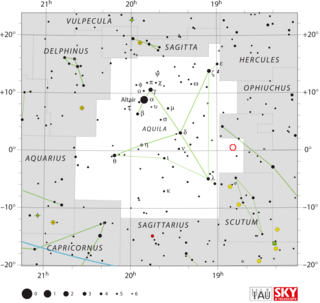
V603 Aquilae was a bright nova first observed in the constellation Aquila in 1918. It was the brightest "new star" to appear in the sky since Kepler's Supernova in 1604. Like all novae, it is a binary system, comprising a white dwarf and donor low-mass star in close orbit to the point of being only semidetached. The white dwarf sucks matter off its companion, which has filled its Roche lobe, onto its accretion disk and surface until the excess material is blown off in a thermonuclear event. This material then forms an expanding shell, which eventually thins out and disappears.
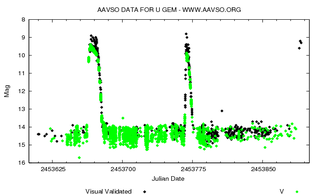
U Geminorum, in the constellation Gemini, is an archetypal example of a dwarf nova. The binary star system consists of a white dwarf closely orbiting a red dwarf. Every few months it undergoes an outburst that greatly increases its brightness. The dwarf nova class of variable stars are often referred to as U Geminorum variables after this star.
DT Virginis, also known as Ross 458, is a binary star system in the constellation of Virgo. It has an apparent visual magnitude of 9.79 and is located at a distance of 37.6 light-years from the Sun. Both of the stars are low-mass red dwarfs with at least one of them being a flare star. This binary system has a circumbinary sub-stellar companion.

HW Virginis, abbreviated HW Vir, is an eclipsing binary system, approximately 563 light-years away based on the parallax measured by the Gaia spacecraft, in the constellation of Virgo. The system comprises an eclipsing B-type subdwarf star and red dwarf star. The two stars orbit each other every 0.116795 days.
WZ Sagittae is a cataclysmic dwarf nova star system in the constellation Sagitta. It consists of a white dwarf primary being orbited by a low mass companion. The white dwarf is about 0.85 solar masses while the companion is only 0.08 solar masses. This implies that the companion is a spectral class L2 star, although this has yet to be confirmed. The distance to this system has been determined by parallax, yielding a distance of 45.1 parsecs.

RX Andromedae is a variable star in the constellation of Andromeda. Although it is classified as a dwarf nova of the Z Camelopardalis (UGZ) type, it has shown low-luminosity periods typical of VY Sculptoris stars. However, for most of the time it varies from an apparent visual magnitude of 15.1 at minimum brightness to a magnitude of 10.2 at maximum brightness, with a period of approximately 13 days.

Mensa is a constellation in the Southern Celestial Hemisphere near the south celestial pole, one of fourteen constellations drawn up in the 18th century by French astronomer Nicolas-Louis de Lacaille. Its name is Latin for table, though it originally commemorated Table Mountain and was known as "Mons Mensae". One of the eighty-eight constellations designated by the International Astronomical Union (IAU), it covers a keystone-shaped wedge of sky 153.5 square degrees in area. Other than the south polar constellation of Octans, it is the most southerly of constellations and is observable only south of the 5th parallel of the Northern Hemisphere.

NN Serpentis is an eclipsing post-common envelope binary system approximately 1670 light-years away. The system comprises an eclipsing white dwarf and red dwarf. The two stars orbit each other every 0.13 days.

Y Sextantis, abbreviated as Y Sex, is a variable star system in the equatorial constellation of Sextans. The system is invisible to the naked eye with a mean apparent visual magnitude of 9.88. It is located roughly at 1,300 light years from the Sun based on parallax.
QS Virginis is an eclipsing binary system approximately 163 light-years away from the Sun, forming a cataclysmic variable. The system comprises an eclipsing white dwarf and red dwarf that orbit each other every 3.37 hours.

Z Chamaeleontis is a dwarf nova variable star system approximately 377 light-years away from the Sun, where two stars orbit each other every 1.78 hours. The system comprises an eclipsing white dwarf and red dwarf and possibly a yet unconfirmed third low-mass substellar companion.

HU Aquarii is an eclipsing binary system approximately 620 light-years away from the Sun, forming a cataclysmic variable of AM Herculis-type. The two stars orbit each other every 2.08 hours and the ultra-short binary system includes an eclipsing white dwarf and red dwarf.
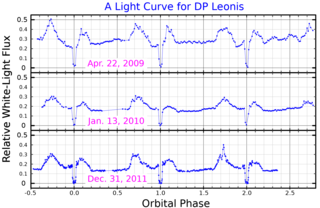
DP Leonis is binary star system in the equatorial constellation of Leo. It is a variable star that ranges in apparent visual magnitude from 17.5 down to 19. The system is located at a distance of approximately 990 light-years from the Sun based on parallax. It is a cataclysmic variable star of the AM Herculis-type also known as polars. The system comprises an eclipsing white dwarf and red dwarf in tight orbit and an extrasolar planet. This eclipsing variable was discovered by P. Biermann and associates in 1982 as the optical counterpart to the EINSTEIN X-ray source E1114+182.
SW Sextantis variable stars are a kind of cataclysmic variable star; they are double-star systems in which there is mass transfer from a red dwarf to a white dwarf forming a stable accretion disc around the latter. Unlike other non-magnetic cataclysmic variables, the emission lines from hydrogen and helium are not doubled, except briefly near phase 0.5. In eclipsing systems, the emission lines are scarcely detected at minimum light because the white dwarf and the central part of the accretion disc are hidden behind the red dwarf.
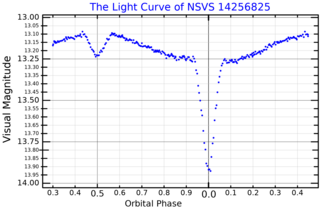
NSVS 14256825, also known as V1828 Aquilae, is an eclipsing binary system in the constellation of Aquila. The system comprises a subdwarf OB star and red dwarf star. The two stars orbit each other every 2.648976 hours. Based on the stellar parallax of the system, observed by Gaia, the system is located approximately 2,700 light-years away.

UZ Fornacis is a binary star in the constellation of Fornax. It appears exceedingly faint with a maximum apparent magnitude 17.0. Its distance, as measured by Gaia using the parallax method, is about 780 light-years.
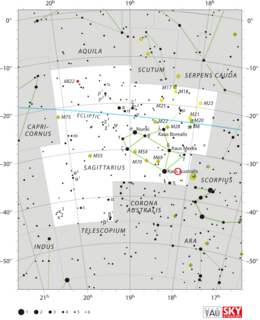
V630 Sagittarii was a nova visible to the naked eye in 1936. It was discovered on 3 October 1936 by Shigeki Okabayashi of Kobe, Japan when it had an apparent magnitude of 4.5.
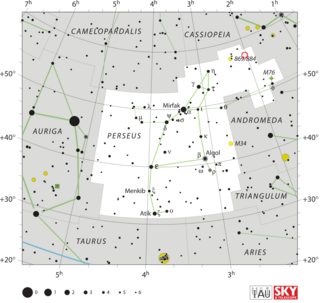
V Persei, also known as Nova Persei 1887 was discovered by Williamina Fleming on a Harvard College Observatory objective-prism photograph taken on 3 November 1887. It is believed to be the first nova whose spectrum was recorded. The nova had an apparent magnitude of 9.2 at the time of discovery. Judging from the consistency of the nova's brightness after discovery, and details of the spectral lines seen, McLaughlin estimated that the nova was five or six months past peak brightness at the time of its discovery, and at its peak it was almost certainly at least as bright as 4th magnitude. So V Persei was probably visible to the naked eye, though there is no record that anyone actually noticed it when that was possible. It is currently an 18th magnitude object.

QZ Aurigae, also known as Nova Aurigae 1964, was a nova which occurred in the constellation Auriga during 1964. It was discovered by Nicholas Sanduleak on an objective prism photographic plate taken at the Warner and Swasey Observatory on 4 November 1964. Examination of pre-discovery plates from Sonneberg Observatory showed that the eruption occurred in early February 1964, and it had a photographic magnitude of 6.0 on 14 February 1964. Its brightness declined in images taken after the 14th, suggesting that its peak brightness was above 6.0. It was probably visible to the naked eye for a short time.

















